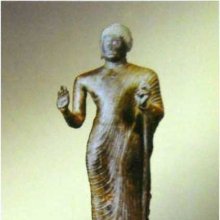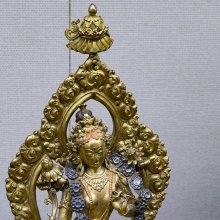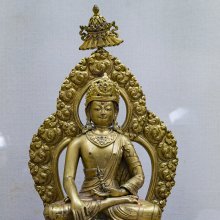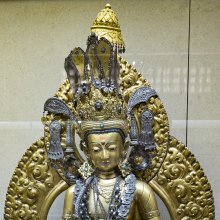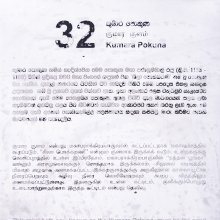Nam, Ṅam, Ñam, Naṃ, Nām: 14 definitions
Introduction:
Nam means something in Buddhism, Pali, Hinduism, Sanskrit, the history of ancient India, Hindi, Tamil. If you want to know the exact meaning, history, etymology or English translation of this term then check out the descriptions on this page. Add your comment or reference to a book if you want to contribute to this summary article.
Images (photo gallery)
(+22 more images available)
In Hinduism
Vyakarana (Sanskrit grammar)
Source: Wikisource: A dictionary of Sanskrit grammarṄam (ङम्).—A short term or Pratyahara for the consonants ङ्, ण् (ṅ, ṇ), and न् (n). See ङ् (ṅ) (3).
--- OR ---
Ñam (ञम्).—A short term (प्रत्याहार (pratyāhāra)) for the five nasal consonants ङ्,ञ्, ण्, न् (ṅ, ñ, ṇ, n), and म् (m) .
--- OR ---
Nām (नाम्).—The genitive affix आम् (ām) together with the augment न् (n) prefixed to it; cf. नामि (nāmi) P. VI. 4. 3.

Vyakarana (व्याकरण, vyākaraṇa) refers to Sanskrit grammar and represents one of the six additional sciences (vedanga) to be studied along with the Vedas. Vyakarana concerns itself with the rules of Sanskrit grammar and linguistic analysis in order to establish the correct context of words and sentences.
In Buddhism
Tibetan Buddhism (Vajrayana or tantric Buddhism)
Source: OSU Press: Cakrasamvara SamadhiNaṃ (नं) is the bīja associated with Nagara, according to the Cakrasaṃvara-maṇḍala or Saṃvaramaṇḍala of Abhayākaragupta’s Niṣpannayogāvalī, p. 45 and n. 145; (Cf. Cakrasaṃvaratantra, Gray, David B., 2007).—The Cakrasaṃvara mandala has a total of sixty-two deities. [...] Three concentric circles going outward, the body, speech and mind wheels (kāya-vāka-citta), in the order: mind (blue), speech (red), and body (white), with eight Ḍākinīs each in non-dual union with their Ḍākas, "male consorts".
Associated elements of Suvīrā and Heruka:
Circle: kāyacakra (body-wheel) (white);
Ḍākinī (female consort): Suvīrā;
Ḍāka (male consort): Heruka;
Bīja: naṃ;
Body-part: feet;
Pīṭha: Nagara;
Bodily constituent: medas (sweat);
Bodhipakṣa (wings of enlightenment): upekṣābodhyaṅga (awakening of equanimity).

Tibetan Buddhism includes schools such as Nyingma, Kadampa, Kagyu and Gelug. Their primary canon of literature is divided in two broad categories: The Kangyur, which consists of Buddha’s words, and the Tengyur, which includes commentaries from various sources. Esotericism and tantra techniques (vajrayāna) are collected indepently.
India history and geography
Source: Shodhganga: Vernacular architecture of Assam with special reference to Brahmaputra ValleyNam is an Assamese term referring to “devotional song / community singing of hymn”.—It appears in the study dealing with the vernacular architecture (local building construction) of Assam whose rich tradition is backed by the numerous communities and traditional cultures.

The history of India traces the identification of countries, villages, towns and other regions of India, as well as mythology, zoology, royal dynasties, rulers, tribes, local festivities and traditions and regional languages. Ancient India enjoyed religious freedom and encourages the path of Dharma, a concept common to Buddhism, Hinduism, and Jainism.
Languages of India and abroad
Sanskrit dictionary
Source: Cologne Digital Sanskrit Dictionaries: Edgerton Buddhist Hybrid Sanskrit DictionaryNaṃ (नं).—see nam.
--- OR ---
Nam (नम्).—(naṃ = Pali naṃ, Prakrit ṇaṃ; variously regarded as from Sanskrit nanu or nūnam), asseverative particle, assuredly, certainly, of course; recognized by Senart only at Mahāvastu i.314.11 (see his note), where it is not wholly certain. Clearer cases: āgatvā ca bhuvaṃ śreṣṭhi(ṃ) naṃ (so several mss.) dhruvaṃ pratipatsyase,…yaṃ śraddhā taṃ samācara (misunderstood and wrongly em. by Senart) Mahāvastu i.187.5(—6), and having come, śreṣṭhin, to the spot (where Buddha is), you will assuredly attain security;… (now) do what seems best to you; na ca śaknoti ārādhayitum, tāye (mss. yāye) ca naṃ godhā hṛdayaṃ gatā ii.66.11, and he could not pacify her, (because) of course the (incident of the) lizard had gone to her heart (turned her against him); tāta mā naṃ antarāyaṃ karohi ii.408.10, father, do not, assuredly, make any obstacle (for the Bodhisattva); Mahāvastu i.168.18 (verse), see s.v. vairambha.
Source: Cologne Digital Sanskrit Dictionaries: Shabda-Sagara Sanskrit-English DictionaryṆam (णम्).—[ṇama] r. 1st cl. (namati) 1. To salute with reverence or respect. 2. To bow down or bent, to bow down in homage or worship. 3. To sound. With ava or āṅ or or sam prefixed, To bend down, to decline. With pra, to bow, to salute. With ut, To lift up, to raise, to make straight or erect. śabde aka-natau saka bhvā-para-aniṭ .
--- OR ---
Nam (नम्).—[nama] r. 1st cl. (namati) To bow, to pay obeisance. r. 10th cl. (namayatināmayati) To bend, to bow: see ṇama .
Source: Cologne Digital Sanskrit Dictionaries: Benfey Sanskrit-English DictionaryNam (नम्).—i. 1, [Parasmaipada.] (also [Ātmanepada.], Mahābhārata 3, 1200, especially when intrausitive), 1. To bow to (with dat., gen. and acc.),
— With the prep. abhi abhi, To bow to, [Indralokāgamana] 2, 19.
— With ava ava, 1. To bow, [Bhāgavata-Purāṇa, (ed. Burnouf.)] 5, 25, 4. 2. To stoop, Mahābhārata 1, 5336 (anomal red. pf. nanāmire). avanata, 1. Stooping, Mahābhārata 3, 1776. 2. Bent, crooked, [Rāmāyaṇa] 2, 56, 7; [Kumārasaṃbhava, (ed. Stenzler.)] 5, 86. 3. Sunk in (not prominent), [Rāmāyaṇa] 6, 23, 12. [Causal.] 1. To cause to bow, [Harivaṃśa, (ed. Calc.)] 3586. 2. To bend (a bow), Mahābhārata 8, 4606.
— With abhyava abhi-ava, [Causal.] To bend downward, Mahābhārata 3, 10062.
— With ā ā, 1. To bow, [Rāmāyaṇa] 2, 25, 38. 2. To bow to (acc.), [Bhāgavata-Purāṇa, (ed. Burnouf.)] 8, 23, 3. ānata, 1. Stooping, [Harivaṃśa, (ed. Calc.)] 6344. 2. Stooping to (with acc.), [Bhāgavata-Purāṇa, (ed. Burnouf.)] 1, 2, 2. 3. Submissive, [Mānavadharmaśāstra] 7, 69. 4. Bent, Mahābhārata 1, 1667. [Causal.] 1. To bend downward, 5561. 2. To subdue, 4, 967. 3. To bend (a bow), 1, 7088.
— With ud ud, 1. To rise, [Pañcatantra] ii. [distich] 98. 2. To erect, to raise, [Pañcatantra] i. [distich] 407. unnata, 1. Erected, upright. [Hitopadeśa] 76, 6; raised, [Draupadīpramātha] 5, 1. 2. High, [Kirātārjunīya] 5, 15. 3. Sublime, [Pañcatantra] 24, 17. 4. Prominent, [Mṛcchakaṭikā, (ed. Stenzler.)] 144, 18. 5. Vaulted, [Bhartṛhari, (ed. Bohlen.)] 1, 41. [Causal.] To raise [Rāmāyaṇa] 5, 30, 12.
— With abhyud abhi-ud, abhyunnata, Elevated, [Śākuntala, (ed. Böhtlingk.)] [distich] 56.
— With samabhyud sam-abhi-ud, samabhyunnata, Risen, [Mṛcchakaṭikā, (ed. Stenzler.)] 76, 20.
— With prod pra-ud, pronnata, 1. Very elevated, [Pañcatantra] 118, 9. 2. Superior, i. [distich] 387. [Causal.] To erect, [Bhāgavata-Purāṇa, (ed. Burnouf.)] 8, 21. 3.
— With samud sam-ud, samunnata, 1. Upright, [Hitopadeśa] 76, 6. 2. High, [Rājataraṅgiṇī] 5, 38. 3. Sublime, Kām. Nītis. 1, 64. 4. Prominent, [Rāmāyaṇa] 3, 52, 30. 5. Vaulted, [Amaruśataka, (ed. Calcutt.)] 51. [Causal.] To raise, [Śākuntala, (ed. Böhtlingk.)] 40, 16.
— With upa upa, 1. To fall to one’s share (with dat. and gen.), [Bhāgavata-Purāṇa, (ed. Burnouf.)] 5, 14, 14. 2. To present one with (acc. of the person and instr. of the object), 6, 19, 16. upanata, 1. One who has submitted to somebody, Mahābhārata 1, 5623. 2. Approached, [Raghuvaṃśa, (ed. Stenzler.)] 10, 40. 3. Near, [Bhāgavata-Purāṇa, (ed. Burnouf.)] 5. 26, 18. 4. Due, 4, 27, 25.
— With nis nis ṇam ṇam, ntrṇata, Prominent, Mahābhārata 7, 7894.
— With pari pari ṇam ṇam, 1. To stoop (as an elephant about to strike with his tusks), [Śiśupālavadha] 18, 27. 2. To turn aside, [Bhartṛhari, (ed. Bohlen.)] 1, 4. 3. To change into (instr.), [Kirātārjunīya] 13, 44. 4. To be digested, [Pañcatantra] 232, 7. 5. To grow old, [Kirātārjunīya] 5, 37. pariṇata, 1. Changed into (instr.), [Meghadūta, (ed. Gildemeister.)] 46. 2. Ripe, Mahābhārata 5, 1109. 3. Advanceed, [Pañcatantra] 197, 18. m. An elephant stooping to strike with his tusks, [Daśakumāracarita] in
— With pra pra ṇam ṇam, 1. To bow, [Mānavadharmaśāstra] 2, 197. 2. To bow to, [Mānavadharmaśāstra] 8, 23. praṇata, 1. Bowing, [Mānavadharmaśāstra] 11, 195. 2. Bowing to (with gen. and acc.), Mahābhārata 4, 202; [Rāmāyaṇa] 1, 52, 1. [Causal.] 1. To order to bow to, [Kumārasaṃbhava, (ed. Stenzler.)] 7. 27. 2. To bend, [Mālavikāgnimitra, (ed. Tullberg.)] [distich] 47. 3. To give. respectfully, [Amaruśataka, (ed. Calcutt.)] 82.
— With abhipra abhi-pra, 1. To bow, Ram. 1, 18, 5 Gorr. 2. To bow to, 2, 100, 37 Gorr. abhipraṇata, 1, 70, 5 Gorr.
— With saṃpra sam-pra, To bow to, [Rāmāyaṇa] 2, 112, 23.
— With vi vi, 1. To bow, Mahābhārata 3, 2929. 2. To bend, [Bhartṛhari, (ed. Bohlen.)] 1, 66. vinata, 1. Sunk down, drooping, [Śākuntala, (ed. Böhtlingk.)] [distich] 58; cast down. [Brāhmaṇavilāpa] 1, 13. 2. Bent, [Rāmāyaṇa] 3, 50, 2. 3. Stooping, [Ghaṭakarpara, (ed. Cale.)] 18. f. tā, 1. A sort of basket. 2. The wife of Kaśyapa and mother of Araṇa and Garuḍa. [Causal.] 1. To bend down, Mahābhārata 3, 15588. 2. To bend, 4, 394; (a bow), 1, 5436. 3. To incline, [Amaruśataka, (ed. Calcutt.)] 81.
— With sam sam, 1. To bow, [Rāmāyaṇa] 2, 72, 30. 2. To bow to, Mahābhārata 5, 1130. 3. To submit to, [Raghuvaṃśa, (ed. Stenzler.)] 18, 33. saṃnata, 1. Bent, [Rāmāyaṇa] 3, 16, 5. 2. Curved, [Kumārasaṃbhava, (ed. Stenzler.)] 1, 34. 3. Stooping, [Indralokāgamana] 1, 10. 4. Bowed to, [Bhāgavata-Purāṇa, (ed. Burnouf.)] 7, 4, 32. [Causal.] 1. To bend, Mahābhārata 12, 10675. 2. To cause to sink, [Bhāgavata-Purāṇa, (ed. Burnouf.)] 8, 18, 20.
— Cf. [Gothic.] and [Anglo-Saxon.] niman (originally, to subdue); perhaps A. S. ge -nedhan (cf. nata).
Source: Cologne Digital Sanskrit Dictionaries: Cappeller Sanskrit-English DictionaryNam (नम्).—namati namate [participle] nata (q.v.) bend, bow (mostly [intransitive]), yield or submit to ([dative] or [genetive], [rarely] [accusative]); aim at ([genetive]) with ([instrumental]). [Causative] namayati or (mostly —°) nāmayati (nāmyati) cause to bend, curve; [with] cāpam or dhanus bend a bow; cerebralize ([grammar]). [Intensive] nannamīti bend ([intransitive]), bow very low.
Source: Cologne Digital Sanskrit Dictionaries: Monier-Williams Sanskrit-English Dictionary1) Nam (नम्):—[class] 1. [Parasmaipada] namati ([Dhātupāṭha xxiii, 12]), te (mostly intrans.; cf. [Pāṇini 3-1, 89]; [present participle] [Ātmanepada] namāna, [Rāmāyaṇa]; [perfect tense] [Parasmaipada] nAnAma, [Ṛg-veda] etc.; 2. sg. nemitha, or nanantha, [Vopadeva]; [subjunctive] nanamas, [Ṛg-veda]; 3. [plural] nemur, [Kāvya literature]; [Ātmanepada] neme, [Ṛg-veda]; 3. [plural] -nanamire, [Mahābhārata]; [Aorist] [Parasmaipada] anān, [Kāṭhaka]; anaṃsīt, [Daśakumāra-carita]; [Ātmanepada] anaṃsta [grammar]; 3. [plural] anaṃsata, [Brāhmaṇa]; [subjunctive] naṃsai, naṃsante, [Ṛg-veda]; [future] naṃsyati, [Brāhmaṇa]; namiṣyati, [Harivaṃśa]; nantā, [Siddhānta-kaumudī]; [infinitive mood] -namam, -name, [Ṛg-veda]; nantum, namitum, [Kāvya literature]; [indeclinable participle] natvā, [Bhāgavata-purāṇa; Kathāsaritsāgara]; -natya, [Brāhmaṇa]; -namya, [Mahābhārata])
—to bend or bow (either trans. or oftener intr.) to bow to, subject or submit, one’s self (with [genitive case] [dative case] or [accusative]), [Ṛg-veda] etc. etc.;
— (with hiruk) to turn away, keep aside, [Atharva-veda iv, 1, 3];
—to turn towards id est. to aim at ([genitive case]) with ([instrumental case]), [Ṛg-veda i, 165, 6];
—to yield or give way, keep quiet or be silent, [Bālarāmāyaṇa vi, 12];
— (in gram.) to change a dental letter into a cerebral, [Ṛgveda-prātiśākhya] :—[Passive voice] namyate, to be bent or bowed;—yield or submit to, [Taittirīya-upaniṣad iii, 10, 4] :—[Causal] namayati, [Ṛg-veda] etc. etc. (nāmayati, [Upaniṣad] etc.; nāmyati [!] [Mṛcchakaṭikā i, 30]; [Aorist] anīnamat, [Ṛg-veda]; [Passive voice] nāmyate, ti, [Mahābhārata] etc.)
—to cause to bow or sink, incline, [Ṛg-veda] etc. etc.;
— (with cāpam) to bend a bow, [Mahābhārata; Harivaṃśa] etc.;
—to turn away or ward off, [Ṛg-veda];
—to aim at ([genitive case]), [ix, 97, 15];
— (in gram.) to change a dental letter into a cerebral, [Ṛgveda-prātiśākhya] :—[Desiderative] ninaṃsati, [Gr.] :—[Intensive] nannamīti, [Ṛg-veda];—nannamyate, [Kātyāyana-śrauta-sūtra] (3. sg. namnate [imperfect tense] anamnata, p. namamāna, [Ṛg-veda]) to bow or submit one’s self to ([dative case]), [Ṛg-veda; Brāhmaṇa]
2) cf. [Zend] nam, nemaiti; [Greek] νέμω, νέμος, νόμος; [Latin] nemus; [Gothic], Old [Saxon], [Anglo-Saxon] niman; Hgerm. nëman, nëmen, nehmen.
Source: Cologne Digital Sanskrit Dictionaries: Yates Sanskrit-English DictionaryṆam (णम्):—(au) namati 1. a. To salute with reverence or respect. With ava, ā or saṃ to bend; with ut to erect; with pra to bow or salute.
Source: DDSA: Paia-sadda-mahannavo; a comprehensive Prakrit Hindi dictionary (S)Nam (नम्) in the Sanskrit language is related to the Prakrit words: Alla, Ṇama, Ṇisuḍha.
[Sanskrit to German]
Sanskrit, also spelled संस्कृतम् (saṃskṛtam), is an ancient language of India commonly seen as the grandmother of the Indo-European language family (even English!). Closely allied with Prakrit and Pali, Sanskrit is more exhaustive in both grammar and terms and has the most extensive collection of literature in the world, greatly surpassing its sister-languages Greek and Latin.
Hindi dictionary
Source: DDSA: A practical Hindi-English dictionaryNam in Hindi refers in English to:—(a) moist; humid, damp; —[hona, amkhem] eyes to get wet, tears to show up in the eyes..—nam (नम) is alternatively transliterated as Nama.
...
Tamil dictionary
Source: DDSA: University of Madras: Tamil LexiconNam (நம்) < நாம். [nam.] The form which nām assumes before case-suffixes; நாம் என்பது வேற் றுமையுருபுகளை ஏற்கும்போது அடையும் உருவம். [nam enpathu ver rumaiyurupugalai erkumbothu adaiyum uruvam.] — particle An infix added to the word ellām before case-suffixes when it is uyartiṇai; எல்லாம் என்ற சொல் உயர்திணையாயின் அஃது உருபேற்கும்போது கொள்ளுஞ் சாரியை. உயர்திணை யாயி னம்மிடை வருமே [ellam enra sol uyarthinaiyayin aqthu uruperkumbothu kollugn sariyai. uyarthinai yayi nammidai varume] (தொல். எழுத். [thol. ezhuth.] 190).
--- OR ---
Nam (நம்) noun < nam. Homage, worship; வணக்கம். (இலக்கியச் சொல்லகராதி) [vanakkam. (ilakkiyas sollagarathi)]
--- OR ---
Nām (நாம்) noun Fear, dread, terror; அச்சம். [acham.] (தொல். சொல். [thol. sol.] 365.)
--- OR ---
Nām (நாம்) pronominal
1. [K. nāvu.] We; தன்மைப்பன்மைச்சொல். [thanmaippanmaichol.] (தொல். சொல். [thol. sol.] 164.)
2. You, used honorifically; தாங்கள். நடந்தவரோ நாமென்ன [thangal. nadanthavaro namenna] (கம்பராமாயணம் சூர்ப்ப. [kambaramayanam surppa.] 119).
Tamil is an ancient language of India from the Dravidian family spoken by roughly 250 million people mainly in southern India and Sri Lanka.
See also (Relevant definitions)
Starts with (+921): Janja, Kandita, Na-matikol, Naam-padaavalee, Naamkaam, Nam laai pang phon, Nam phrom, Nam saam duwsng, Nam ti ba, Nam tif baf, Nam-chapi, Nam-khaikung, Nam-lao, Nama, Nama nazan, Nama Sutta, Nama-bikaunu, Nama-griha, Nama-kamaunu, Nama-kridanta.
Ends with (+3359): A-piracittavicetanam, Abhidakshinam, Abhikkhanam, Abhikrishnam, Abhikshnam, Abhinam, Abhinidhanam, Abhipradakshinam, Abhipranam, Abhisamnam, Abhishnam, Abhisvayamatrinnam, Abhyavanam, Aca-kalatanam, Acalapattanam, Acamanam, Acanam, Acannam, Acataranam, Acattiyaniruvanam.
Full-text (+4136): Sammana, Viparinama, Prakopana, Nirnam, Vinamana, Nama-kamaunu, Samudayavacaka-nama, Adhyashana, Unnama, Sudana, Dhvamsana, Prakashana, Alina, Abhyasadana, Krandana, Pranatavat, Uttana, Abhipranam, Fin naam, Anamya.
Relevant text
Search found 90 books and stories containing Nam, Ṅam, Ñam, Naṃ, Nām, Ṇam, Naam; (plurals include: Nams, Ṅams, Ñams, Naṃs, Nāms, Ṇams, Naams). You can also click to the full overview containing English textual excerpts. Below are direct links for the most relevant articles:
Blue Annals (deb-ther sngon-po) (by George N. Roerich)
Chapter 23 - Mind instruction lineage (iv): nam mkha' bsod nams pa < [Book 8 - The famous Dakpo Kagyü (traditions)]
Chapter 23 - Mind instruction lineage < [Book 8 - The famous Dakpo Kagyü (traditions)]
Chapter 13 - Staglungpa (ix): Ratnākara < [Book 8 - The famous Dakpo Kagyü (traditions)]
Tiruvaymoli (Thiruvaimozhi): English translation (by S. Satyamurthi Ayyangar)
Pasuram 2.6.3 < [Section 6 - Sixth Tiruvaymoli (Vaikunta Manivannane)]
Pasuram 6.10.6 < [Section 10 - Tenth Tiruvaymoli (Ulakam unta Peruvaya)]
Pasuram 8.3.10 < [Section 3 - Third Tiruvaymoli (Ankum inkum)]
Guhyagarbha Tantra (with Commentary) (by Gyurme Dorje)
11. The Khams Tradition of Kah-thog < [Introduction]
13. Extensive Propagation of the “distant lineage” in Khams < [Introduction]
Text 9.16 (Commentary) < [Chapter 9 (Text And Commentary)]
Bodhisattvacharyavatara (by Andreas Kretschmar)
Śāntideva’s Bodhisattva-caryāvatāra - Tibetan Text
Khenpo Kunpal's Commentary (tibetan)
Khenpo Ape’s Advice On Studying The Bodhisattva-caryāvatāra < [Introduction Text]
Dhammapada (Illustrated) (by Ven. Weagoda Sarada Maha Thero)
Verse 42 - The Story of Nanda, the Herdsman < [Chapter 3 - Citta Vagga (Mind)]
Verse 2 - The Story of Maṭṭakuṇḍali < [Chapter 1 - Yamaka Vagga (Twin Verses)]
Verse 1 - The story of the monk Cakkhupāla < [Chapter 1 - Yamaka Vagga (Twin Verses)]
Rig Veda (translation and commentary) (by H. H. Wilson)
